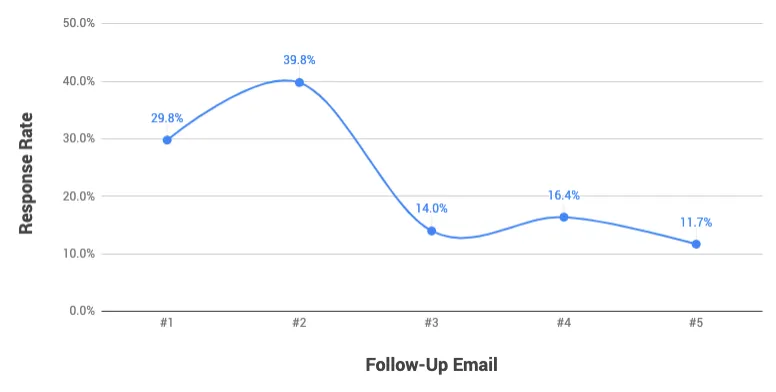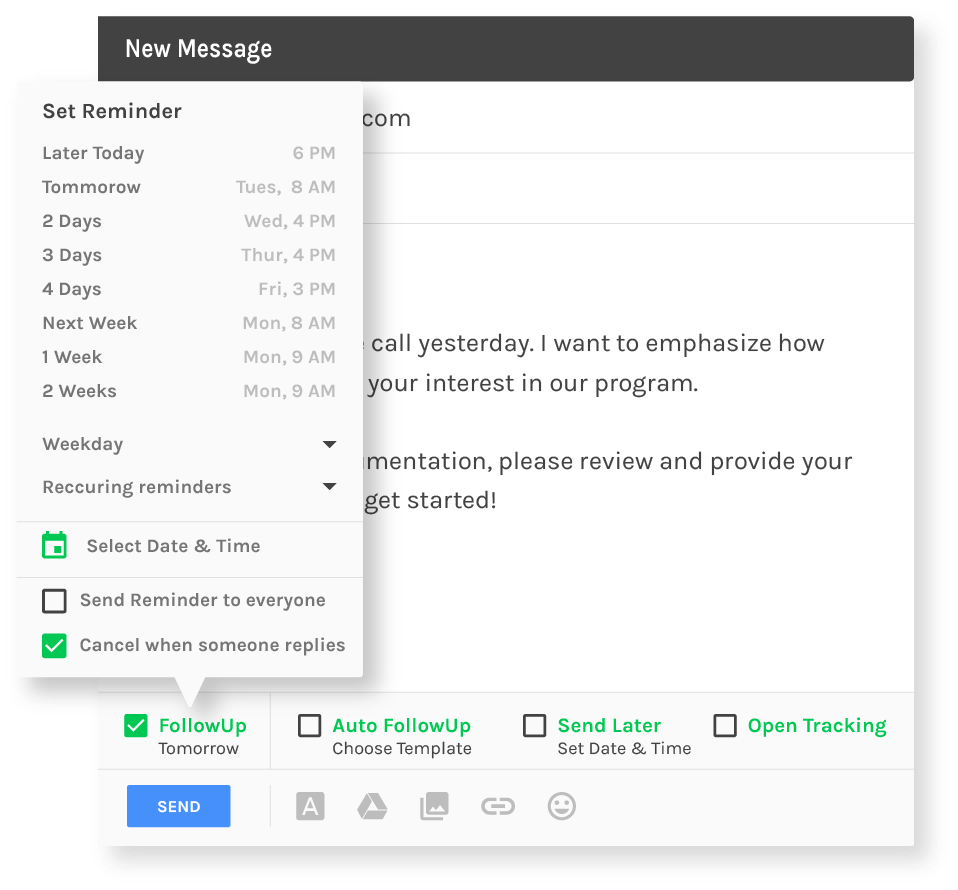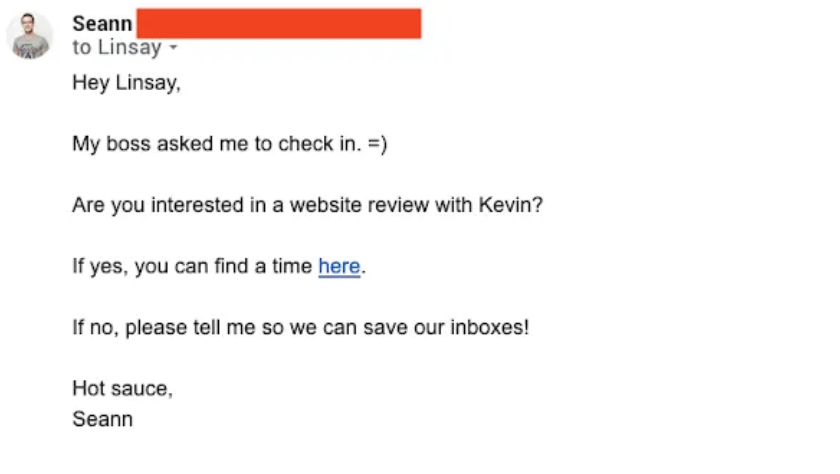Dean, the Head of Content at Sumo, wouldn’t be here if not for his follow-up emails.
Here’s what Noah replied after a series of back-and-forth emails (and weeks of follow-up).

If you’re not following up on your emails, you’re missing out on huge opportunities.
It’s easy to make up excuses about why you shouldn’t follow up:
-
“I don’t want to seem annoying.”
-
“I’m sure they’ll get back to me; I’ll just keep waiting.”
-
“I'm afraid I'm being too pushy.”
And even if you do pluck up the courage to send an email, it’s all too common to send BAD follow-up emails using phrases like:
“Thought I’d check in on this” or “Bumping this to the top of your inbox”
(Spoiler alert: These types of emails will almost always end up in the trash.)
If you want to understand WHY you should send follow-up emails, and learn how to write great follow-ups that inspire action and help you achieve your objectives…
…This post is for you.
%(tableofcontents)
What Is A Follow-Up Email?
A follow-up email is an email you send after an important event or after a message hasn’t been replied to. For example:
-
After a job interview, you might send a follow-up email to thank the interviewer for their time.
-
After a prospect hasn’t replied to a sales email, you might follow up and try another angle to make the sale.
-
After your latest invoice is overdue, you might need to chase the payment.
Why You Should Send Follow-Up Emails
Executives and CEOs can receive a lot of emails. Couple that with text messages, social media posts… plus actual work, and that’s a lot to deal with each day. So it’s easy to see how one email could slip through the cracks.
Following up gives your message more or a chance of being seen and getting a reply.
Sending follow-up emails is an important job for the growth team at Sumo. The Sumo team has found that response rates to follow-up emails can be even higher than initial emails — initial emails tend to receive a response rate of 29.8% BUT follow-up emails received a response rate of 39.8%:

If Sumo’s growth team were to give up on every prospect it reached out to after one email, they’d be waving goodbye to a lot of leads… and revenue!
What Holds People Back From Following Up
I get it. Following up can seem a little awkward. It’s so easy to brush off an opportunity and tell yourself:
“They just can’t have been interested.”
I’ve been there plenty of times. Especially when it comes to following up about freelance work… or even worse, payment. There’s nothing more awkward than chasing up money, right?
You write the email…
Read it 50 times…
Make edits…
Then just as you’re about to hit send… you stop and tell yourself you’ll give it “a few more days.”
Sound familiar?
Here are three reasons people (like you and me) don’t follow up, and some quick ways to change your thinking and ensure you follow up every time from now on.
1. You Don’t Want To Seem Pushy
So you had a job interview / sales call / meeting. It went great, you sent an initial email and… nothing comes back.
After a couple of days you want to follow up, but at the same time you don’t want to appear like a pushy salesperson who’s desperate to get a reply.
Solution: Give it time and think of following up as your responsibility.
You don’t want to follow up an email after 2 or 3 hours without receiving a response, but 2-3 days is more than likely fine (no matter who you’re talking to).
As a salesperson / interviewee (AKA the person chasing a response or deal from the prospect), you should also view following up as a responsibility of yours — it’s not being pushy, it’s just the best practice to help you reach your goal.
Would you really want to miss out on a life-changing job or deal because you didn’t want to seem pushy? After all, following up on an email or interview after a few days really isn’t being pushy.
2. You Forget To Follow Up
“Ah no! I meant to reply to that email last week!”
It’s happened to us all, right? You send an email and have the best intentions to follow up. Then, days or weeks pass, and suddenly you realize you forgot, and now it’s too late.
Solution: Set reminders
We’re all busy people and it’s nearly impossible to remember every task you need to do without some help. Every time you send an important email, set a reminder to follow up if you don’t receive a response.
Tools like FollowUp.cc can automate this process for you, or you could set a reminder in your calendar to follow up on your chosen date.

3. You Think The Prospect Will Reply ‘In Their Own Time’
One of the most common myths that people fall prey to. It’s easy to tell yourself that if your initial email was —
-
Well researched
-
Concise
-
Clear in its CTA
— you’ll get a response and won’t need to follow up. But the reality is people get busy and they forget to reply.
Solution: Act like a pro
The growth team at Sumo follows up on every unanswered email that’s sent to prospects. Following up is a part of their job… and they get results. A professional salesperson would never expect a prospect to do the work and dig up a days- (or weeks-) old email by themselves.
Before you send an email, set out a simple roadmap for how you’ll follow up if you don’t get a reply. For example:
-
Day 1: Send the email
-
Day 3: Follow-up email
-
Day 5: Second follow-up email
How To Write A Follow-Up Email In 4 Simple Steps
So hopefully you’re now over your fear of following up.
Next, it’s time to write your follow-up emails. Here are four steps to help you craft irresistible emails.
1. Understand Your Goal
First, you need to think about why you’re sending the email.
-
Are you trying to learn more about a job opportunity?
-
Do you want to book a meeting?
-
Do you simply want to say “thanks”?
Each of these scenarios will require a very different follow-up email and you should always decide what your goal is before you send (or even write) a follow-up email.
The goal of your message will help you to decide what the call to action (more in Step 3) will be.
2. Share Context
It’s important to let your recipient know why you’re emailing them early on in your follow-up email. It can be useful to share details like:
-
Your relationship with them: “I'm following up on a sales inquiry you made on our website last week” or “We spoke briefly at [conference / event last week].”
-
Why you originally reached out: “I messaged your last week after I saw your YouTube video about [subject]” or “I’m keen to learn more about your approach to [a topic, working with freelance writers].”
It’s also great to set out some form of timeframe to help jog the recipient’s memory of your interaction or relationship. For example:
- We had a call last month.
- You were a customer of our marketing software until March 2019.
- I saw your talk at Web Conference 2019 in Lisbon.
If you want to really make an impact on your prospect, you could include some data points and social proof to help show your experience and let them know you can solve problems for their business.
For example, Seann does this in the below email with the line:
“Kevin has done this with some of our top sites like Onnit, Huckberry and Bulletproof. This is your chance to get 30 minutes on his calendar.”

The way Seann frames this email and describes Kevin’s expertise makes it feel like an opportunity the prospect cannot afford to ignore.
Pro tip: A study by MIT found that keeping messages short will improve response times. The findings noted: “Email users who send short focused messages receive demonstrably faster responses than users who send long rambling messages.” [*]
3. Include a Call To Action
A call to action (CTA) is a prompt that tells your recipient what they should do next. Essentially, it’s the step you NEED the recipient to take to achieve the goal you set in Step 1.
For example, in the below email Seann includes a CTA to book a website review with someone on the Sumo team:

4. Write A Relevant Subject Line
Subject lines are the most important part of any email. Without a captivating, clickable subject line, the rest of your email won’t get read. When you’re writing an initial email to follow up after an interview, meeting or event, you need a great subject line.
You could try to use urgency to boost opens:
-
Do you have time to chat this week?
-
Don’t miss out
Ask a question:
-
Could you be generating more leads?
-
How can I help?
Or go descriptive:
-
[Name] from [Company]: 3 Tips to help [solve a problem]
-
We’ve helped brands like [well-known company in recipient's niche] with [problem]
Want more? Check out 87 of the best email subject lines in this post.
If you’re following up on a previously sent email, the best approach is to reply to the initial email.
Follow-Up Email Templates
As you can tell, I’m a huge believer in the power of a quality follow-up email to help you achieve your goals. Plus, I also understand how daunting it can be to actually write an email and hit the send button.
To give you a hand getting your next follow-up email out of the drafts and into the inbox of your prospect, I’ve created a simple template you can use.
Instead of a message you can copy and paste, this is a map to help guide you in the right direction — I believe the best follow-up emails are personal, so a one-size-fits-all approach doesn't work too well.
Note: If you want word-by-word follow-up email samples, we have a post on the follow-up emails used by the Sumo Growth team to get more replies.
The template is split into five sections:
-
Opener
-
Context
-
Proof
-
Action
-
Closer

1. Opener: Open your email in a friendly, welcoming way using words like:
Hey / Howdy / Hi / Heya / Okay [First name]
Example: Hey Samantha
2. Context: State why you’re reaching out, use specific details to give more information about your relationship with the recipient:
[How you know them] + [why you’re following up]
Example: Just finished your latest YouTube video on how you approach content marketing at Company Name. Loved it! I reached out a few days about a freelance writing opportunity I saw you tweet about.
3. Proof: Let the recipient know why they should care about you / your business and prove you can solve a specific problem for them.
[Data / info to qualify your work] + [social proof]
Example: I helped to grow Example Company’s web traffic from 10k per month to 400k and my work has been featured by Adobe, TechCrunch, and FastCompany.
4. Action: Make it clear what you’d like the recipient to do at the end of your email.
[Call to action]
Example: Do you have time to chat on Friday? You can book a call with me here.
5. Closer: Thank the recipient for their time and close with your name.
Example: Thanks so much, Ash
When you stitch together all of those elements, here’s how the email reads:
Hey Samantha,
Just finished your latest YouTube video on how you approach content marketing at Sumo. Loved it! I reached out a few days about a freelance writing opportunity I saw you tweet about.
I helped to grow Example Company’s web traffic from 10k per month to 400k and my work has been featured by Adobe, TechCrunch, and FastCompany.
Do you have time to chat on Friday? You can book a call with me here.
Thanks so much,
Ash
And here’s another copy of the template:
[Hey / Howdy / Hi / Heya / Okay First name]
[How you know them] + [why you’re following up]
[Data / info to qualify your work] + [social proof]
[Call to action]
[Thanks / Cheers / All the best, Your Name]
Always Follow Up
Thanks so much for reading. I hope this post has given you the confidence to send follow-up emails and provided everything you need to craft killer email copy.
Remember:
-
If your email doesn’t generate a reply on the day you send it, the chances are it won’t.
-
Set a clear goal for every email you send and ensure you close with a call to action that will help you achieve that goal.
-
Don’t be afraid to follow up more than once. The Sumo team will often send up to five follow-up emails to every prospect.
Is there an email you’re waiting on a reply to? Here's a challenge: Open up your emails right now and send a follow-up.
Dean wouldn’t be here right now if he didn’t follow up. Just think where following up could take you…
Add A Comment
VIEW THE COMMENTS